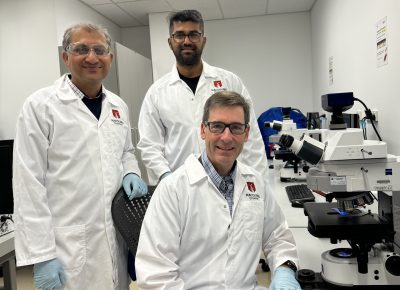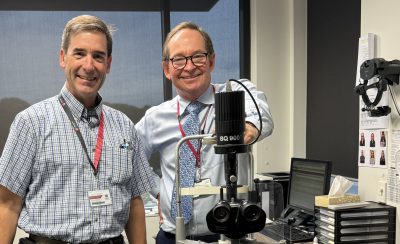2024 Fulbright Senior Scholar Dr. András Komáromy achieved his research objectives in Sydney, Australia, and contributed to the Fulbright mission to conduct research, exchange ideas, and contribute to mutual understanding.
On June 3, 2024, András Komáromy found himself in Sydney, among a sea of 76,798 soccer fans cheering the Australia women's national soccer team in their final home game before leaving for the Paris 2024 Olympics. The Matildas celebrated a 2-0 victory over the China national team.
Komáromy would not have imagined himself in Sydney at a football game before receiving the March 2023 e-mail that he had been granted a 2024 Senior Scholars Fulbright award to conduct glaucoma research in collaboration with glaucoma clinician-scientist Dr. Stuart Graham and glaucoma researcher Dr. Vivek Gupta at the Macquarie Medical School in Sydney, Australia.
Komáromy is a professor of comparative ophthalmology, a board-certified veterinary ophthalmologist, and a vision scientist who focuses on new treatments for glaucoma in dogs that may be translatable to people—the anatomy of the canine and human eye is quite alike, and the two species experience diseases that are strikingly similar.
Glaucoma is a leading cause of blindness in humans and dogs. Even with early diagnosis and current treatments—lowering intraocular pressure—many patients still lose sight. Komáromy brings translational expertise to the team of scientists and ophthalmologists at Macquarie University in developing a therapy that targets the underlying degeneration of the optic nerve.
Promising Findings

The researchers are targeting a protein called neuroserpin that is necessary for healthy neurons and for cells’ ability to communicate with one another. This protein is implicated in glaucoma and Alzheimer's disease, as well as stroke, familial encephalopathy, and other conditions.
The team has published findings showing that neuroserpin dysfunction plays an important role in the retinal degeneration that causes glaucoma. They also demonstrated that protecting neuroserpin protects the retina, and—importantly—that increasing neuroserpin protects the function of retinal cells and restores degenerated networks associated with glaucoma.
These promising findings were achieved in murine models. Murine models, while useful for proof of concept, do not show that a therapy would be effective in people. Dogs, with eyes that are anatomically akin to humans, are the key to seeing if this therapy could effectively treat glaucoma in people. This is the important piece introduced to the project by Komáromy and his team at Michigan State University (MSU).
“I worked with my collaborators to learn novel research techniques they’ve developed and to provide insights for improving the project,” says Komáromy. “At the same time, my research team at MSU continued the work on the dogs with glaucoma, which we initiated before I left for Australia.”
The Future

The research team is about halfway through the current project, which was funded by the Australian National Health and Medical Research Council, or NHMRC. The murine model work at Macquarie University is almost completed, and the Komáromy lab’s work with the dogs at MSU is well underway. But, as Komáromy says, “this is just the beginning!”
“At Macquarie, I also participated in the Dementia Research Centre weekly lab meetings, which was an unexpected but extremely valuable experience, not only for learning new tools but also for establishing new collaborations going forward,” says Komáromy. “Dementia and glaucoma are both neurodegenerative disorders, and I learned during my time at Macquarie University more about the significant overlap between these diseases.”
Several collaborations are now in motion. A doctoral student in Komáromy’s lab began work on neuroserpin gene therapy research. Two of his Macquarie University colleagues, Graham and Gupta, will serve on the student’s PhD Advisory Committee at MSU. Also, the first visit of a Macquarie University PhD student to MSU is scheduled for October 2024.
“My experience at the Dementia Research Center was unexpected but extremely valuable, not only for learning new tools but also for establishing new collaborations going forward,” says Komáromy. “I am excited about new research directions initiated during my visit, most importantly the investigations of similarities between glaucoma and Alzheimer’s disease.”
The team submitted an Ideas Grant application to the Australian NHMRC, and they have laid the groundwork for a larger grant application to the U.S. National Institutes of Health that they will submit in 2025.
“Ultimately, we aim to bring the neuroserpin gene therapy into clinical application for human and canine patients with glaucoma in Australia, the United States, and beyond,” says Komáromy. “And more broadly, the Fulbright Scholarship triggered a much deeper collaboration between our two institutions.”
